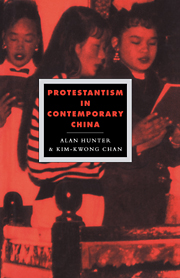Book contents
- Frontmatter
- Contents
- List of figure and tables
- General editors's preface
- Acknowledgements and notes on the text
- List of abbreviations
- Map
- Introduction
- 1 The social and political context
- 2 A survey of the Protestant community
- 3 The historical legacy
- 4 Protestantism and Chinese religious culture
- 5 Varieties of Christian life
- 6 Buddhism and Catholicism
- 7 Into the 1990s
- Bibliography
- Index
2 - A survey of the Protestant community
Published online by Cambridge University Press: 04 May 2010
- Frontmatter
- Contents
- List of figure and tables
- General editors's preface
- Acknowledgements and notes on the text
- List of abbreviations
- Map
- Introduction
- 1 The social and political context
- 2 A survey of the Protestant community
- 3 The historical legacy
- 4 Protestantism and Chinese religious culture
- 5 Varieties of Christian life
- 6 Buddhism and Catholicism
- 7 Into the 1990s
- Bibliography
- Index
Summary
REPORTING STATISTICS
There are Protestants in every province of China. The total number is impossible to determine accurately, and there is a great discrepancy in estimates. The official church claims that there are five or six million registered church members and few unregistered Christians, while unofficial sources suggest that there may be fifty million or even more, most of whom are not affiliated to official organizations. But even if we cannot provide an accurate assessment, we can at least examine this discrepancy and gain some idea of the dimensions of the Protestant community.
There are several major difficulties involved. First is the question of definition. Should one count the baptized, those who call on Jesus when sick, those who attend meetings occasionally or those formally registered with a church? The numbers may be radically different, and many estimates fail to distinguish between such groups. Congregations are constantly fluctuating and new members may be only temporary. With official sources at least this problem is avoided: ‘Christian’ refers to an individual who has been baptized and is registered with a TSPM/CCC church. Another factor is the size of China, the remoteness of some of its regions and the lack of sociological studies, issues discussed in our introduction. A third point is that many believers are not registered with any authority. Government agencies may have some idea of the extent of house churches in particular districts or cities, but many such meetings remain unknown, especially in rural areas.
- Type
- Chapter
- Information
- Protestantism in Contemporary China , pp. 66 - 104Publisher: Cambridge University PressPrint publication year: 1993



